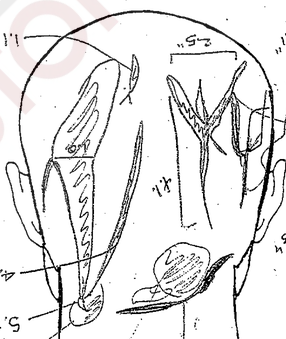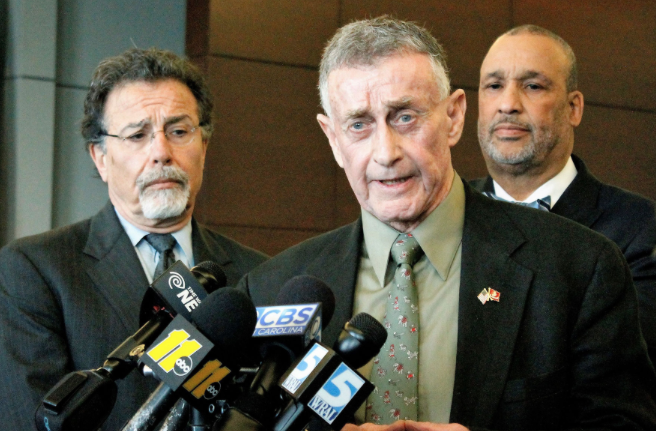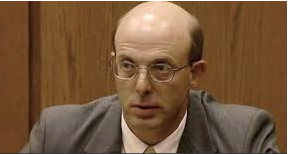By Andrew L. Urban
On a sunny winter Saturday afternoon in Sydney, I started watching The Staircase, thinking I’d spend a couple of hours on it. It was Sunday afternoon, before I finished my binge, only breaking for dinner and sleep. The Staircase is some 13 hours of riveting and disturbing viewing, a slow motion disaster movie in which a man is crushed by the state, the prosecution determined to secure a murder conviction – by fair means or foul.
I had just turned on Netflix to see what was around. It was one of the items ‘suggested for you’. The title immediately rang a bell; it had been recommended to me some years earlier, in fact, by Eve Ash, who made the now controversial doco, Shadow of Doubt, about the police investigation and subsequent conviction of Sue Neill-Fraser, for the murder of her partner, Bob Chappell, in Hobart on Australia Day 2009. (The conviction is still being appealed.) That doco was the motivation for my journalistic interest in wrongful convictions (and which eventually led to the existence of this blog).
Since Eve’s mention about two years ago, when the series was still just 13 episodes long, the producers had made a further four episodes, because the case continued after their initial production was completed in 2004. It continued until 2018, picking up eight years after the subject of the film, Durham, North Carolina author Michael Peterson was convicted of the murder of his wife Kathleen. Wrongfully convicted, that is, in my opinion.
It continued because Peterson’s defence lawyer, David Rudolf, came across a story about the prosecution’s star witness, State Bureau of Investigation (SBI) blood splatter analyst Duane Deever having been caught being dishonest with evidence. Not just once.
Tragic, because it need not … should not … have been what it turned out to be. Tragic because Kathleen’s death was really a mystery – and faced with the unknown, the police blamed Michael, the husband. The evidence, entirely circumstantial relying on forensic testimony, was tailored to fit a case against him, prejudicial material was allowed in and forensic misbehaviour hidden.
After a friendly late night conversation by their lavish pool, Kathleen had left Michael to finish his wine while she went inside to get ready to go to bed. When Michael followed sometime later, he found her at the foot of the staircase – dead in a pool of blood. He went into shock as he called 911.
To Michael, it was a terrible accident. To the police it was a vicious murder. The autopsy showed strange lacerations on the back of Kathleen’s skull. They didn’t match injuries expected from a staircase accident. Surely he beat her to death. With a ‘blow poke’, the fire-prodding implement common in American homes apparently, hollow pokers to allow you to incite the flames while poking the firewood. But there was no bruising or skull damage.

Kathleen Peterson autopsy sketch
When the court was shown the autopsy sketches of the wounds, I sat on the edge of my lounge waiting for someone – anyone – to sing out with an objection: the oddly shaped lacerations do not match a beating with a poker, either. There is something wrong here, but common sense had been evicted from the courtroom. Nobody raised this issue. Not until many years later … many years too late. I’ll come to that shortly.
Step 1 to conviction
Pathologist Deborah Radisch told the jury and stated in her autopsy report that the posterior of the scalp showed multiple (at least 7) deep complex lacerations… no skull fractures were present. “The number, severity, locations, and orientation of these injuries are inconsistent with a fall down the stairs; instead, they are indicative of multiple impacts received as a result of beating.” She could not imagine the truth …. so jumped to a conclusion.
Step 2 to conviction
The prosecution had told the court that the blow poke was “mysteriously missing”. Rudolf later discovered that the police had actually found it, photographed it and put it out of the way. The photo had never been given to the defence. The blow poke without blood stains, DNA or fingerprints to support the murder scenario as presented would have been a threat to a conviction.
Step 3 to conviction
Deever’s rancid testimony convinced the jury that blood splatter proved Michael stood over her and beat her to death. Not that there seemed to be any motive for him to do such a horrific thing. Their friends were unanimous in declaring them a very happy couple.

After being denied the dismissal of the charge due to the flaws and wrongs in the prosecution’s case, Peterson had to choose whether, at 73 and having already spent eight years in jail, he would embark on yet another trial and take his chances, or plead the Alford – a guilty pea that doesn’t admit guilt, sort of. His faithful lawyer David Rudolf could not help him to make the decision. He had no trust left for the system. He pleaded Alford.

Above: David Rudolf (left) with Peterson outside the court
But I’ve boiled down an extensive documentary that is worth watching in full, with all its emotional and intellectual challenges and rewards. French filmmaker Jean-Xavier de Lestrade has given us a complex work that combines elements of an edgy court room drama, true crime and the story of a family in crisis, all pivoted on the central character of Michael Peterson.
The French production company, What’s Up Films, can be proud of this work. Shot and edited like a major feature film, it is accessible and always clear, full of close ups and intimate, dramatic, or amusing moments. (And with a terrific, sensitive score.) We see the human cost as well as the drama of the process. Director de Lestrade told digitalspy.com that “At the beginning, the purpose was really to follow the way the justice system would treat that case. It was from that point of view. I had never been looking for the truth, or doing our own investigation. Never.
prosecution stopped the collaboration
“I was looking at the justice system. And when the verdict came, to me it was like a shock. In fact, in the crew, we were not expecting a guilty verdict. Maybe we were a little bit naïve [laughs] but we were not expecting that.”
He adds: “I really wanted to shoot, in an equal way, the defence and the prosecution. We talked to the defence and the prosecution, explaining the project, and I was ready to have two teams, two crews – one crew for the defence, and one crew for the prosecution. But we didn’t do that. We started shooting with the prosecution, and after four months, the prosecution stopped the collaboration – they stopped the shooting.”
Considering the weakness of the prosecution case, that is not perhaps surprising. All the same, the series is remarkable for the extent of access the crew have to courts, jail and private homes.
In my view, de Lestrade absolutely achieved his objective of reflecting the justice system; and it is a dark reflection. The judge, in a brief contemporary interview, admits he was wrong to allow in certain prejudicial evidence. But he has immunity.
 Deaver suffered no legal repercussions for his perjury, but at least he was eventually fired by the SBI. He now works as Director of Operations at ISS Facilities in Texas, a company providing ‘janitorial services’.
Deaver suffered no legal repercussions for his perjury, but at least he was eventually fired by the SBI. He now works as Director of Operations at ISS Facilities in Texas, a company providing ‘janitorial services’.
Mystery attacker – the owl theory
After I finished watching The Staircase, I immediately began to search the internet for more about the case. Something that might give me some sort of ‘closure’, something denied Peterson. And I found it immediately: the so called owl theory.
As I suspected while watching the trial, the answer to the mystery of how Kathleen died has already been explored around the web. Here is just one such report, published on Esquire:
“…in 2008 (Michael’s) neighbour Larry Pollard put forward the theory via a series of YouTube videos, that Kathleen had been the victim of an attack by a barred owl. They’re common around Durham, North Carolina, where the Petersons lived, and there’s a lot of examples of them attacking people by dive-bombing the head.
“Pollard said that what might have happened is that either the owl got into the Peterson house, got spooked by Kathleen walking into the bedroom, attacked her, and caused her to fall down the stairs, or that she was attacked while in the front garden, out of earshot of Michael, then attempted to walk up the stairs before collapsing down them.
a microscopic feather
“A re-examination of the evidence in 2009 seemed to back the idea up. Kathleen was found to have had a microscopic feather and a sliver of wood from a tree limb caught up in a clump of hair in her hand that had been pulled out by the roots from her head.”
Barred owls are large – and invasive. The adult is 40–63 cm (16–25 in) long with a 96–125 cm (38–49 in) wingspan. Weight ranges from 500 to 1,050 g (1.10 to 2.31 lb). The legs and feet are covered in feathers up to the talons.
The theory answers the question about the source of lacerations and the copious amount of blood lost. The bit of feather tends to reinforce it – and to reinforce the notion that the investigation was inefficient. They didn’t even test Kathleen’s clothes for DNA …
David Rudolf only became aware of the theory just before the summing up of evidence so he could not bring it in, and the documentary sticks to what was said in court, explains de Lestrade. “Because it was never introduced inside the courtroom, I decided not to talk about that theory.”

I remember this when it happened…… shortly after I experienced a very similar situation myself. I survived. Peterson is GUILTY.
What was the evidence that convinced you?
I have watched the Staircase several times now and still remain horrified that the Owl theory was never followed up. It makes so much sense and absolutely fits what happened to Kathleen. There was blood found on the back door – not followed up. Don’t forget she had valium and alcohol on board. They found the feather in her hand – not followed up. The next door neighbour posted online that the laceration marks were similar to the owl’s talons. This was a gross miscarriage of justice and I still think of that occasionally and what a travesty this case turned out to be.
Dr. Deborah Radisch, North Carolina’s assistant medical examiner wasn’t mystified. She told jurors what they already knew from viewing autopsy photos: Kathleen Peterson died “due to severe concussive injury of the brain caused by multiple blunt force impacts of the head.”
Chief medical examiner, Dr. John Butts testified, “the multitude of injuries are not consistent with a fall down the steps,” and flatly stated, “You don’t just get lots and lots of lacerations across the back top of the head.”
James McElhaney, emeritus professor of engineering at Duke University similarly testified to the obvious truth, “You can’t hit the flat stair surface with the top of your head in a fall.” McElhaney noted, “Two of the wounds could be attributed to contacting a horizontal edge like the stairs, but the others are in the wrong direction and start in the wrong place.”
Without question, Kathleen Peterson’s head violently contacted the stairs and surrounding walls, but her main injuries were caused by a very specific weapon. “A blunt instrument, most likely a rounded blunt instrument,” said McElhaney. “A relatively light object striking the head.”
Dr. Kenneth Snell saw Kathleen Peterson’s body at the scene a few hours after police arrived.
Although he indicated “accident” on a preliminary report, Dr. Snell also decided an autopsy was necessary and advised police to begin looking for something like a crowbar or fireplace poker.
All wrong/lying?
I agree that any blunt trauma caused by falling down the stairs would not produce such lacerations, but neither would being beaten with a poker. There was no bruising, it seems, nor skull fracture. I therefore prefer the strange-but-true proposition of the ‘owl theory’. Not only does it make sense from the evidentiary point of view, but also fits the other aspects, eg the couple’s apparently ordinary relationship. Perhaps tellingly, the poker that was accused of being the murder weapon turned out to be innocent. Extraordinary case.
So what has happened here now to this very credible theory?
It’s just there. No further legal action.